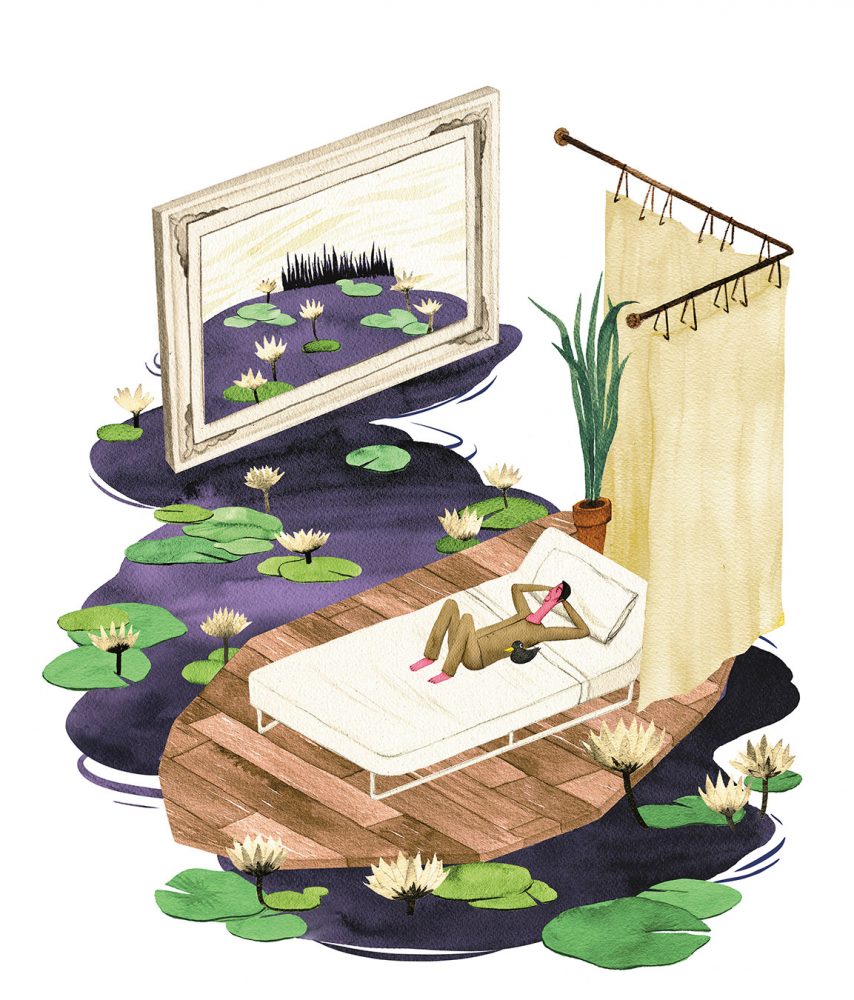The inpatient psychiatric ward of Vancouver General Hospital (VGH) is now experiencing little daily miracles—and they are happening because of art. With the help of a team of art consultants and generous donors, VGH has taken its first steps toward transforming an environment that, for a long time, had been neglected. Throughout the years, the Inpatient Psychiatry department has been an uncomplaining group, as they’ve watched vibrant artworks and renovation funds be dispersed to all corners of the hospital except their own. But, with a little elbow grease and a lot of dedication, the generous group of donors and artists have, in little more than three months, began fulfilling their goal to overhaul the ward.
“We’re used to being the Cinderella of medicine,” says Dr. Kulbir Singh, the medical manager of the inpatient unit and a psychiatrist himself. But Dr. Singh understands very well the arduous fight for resources. “I’ve worked in the some of the poorest hospitals in India and some of the most aristocratic private facilities in the U.S.A. This facility [VGH Inpatient Psychiatry] is for everyone, regardless of their station in life. My patients can range from a celebrated army general to a hard-working taxi driver to a resident of the Downtown Eastside.” And although mental health issues are known to impact the lives of almost every Canadian, be it directly or indirectly, the field has been largelyunderfunded across government, corporate sectors and charitable organizations alike. The drab surroundings of the inpatient psychiatry ward at VGH seemed to reflect that. Untouched for decades, things are finally changing.
It’s a well-known fact that bad hospital design can impede good medicine. When savvy, pregnant baby boomers started seeking well-designed birthing centers and private recovery suites, hospital brass began to wise up to patient needs and desires. In fact, recent research findings confirm that during times of acute emotional or physical stress, a sight of beauty can be particularly useful. Patients (across various cultures and socioeconomic groups) who are exposed to art recover more quickly, ask for less pain medication, have shorter hospital stays and are less depressed and agitated. They also experience lower blood pressure, heart rate and muscle tension, and feel a greater sense of autonomy.
VGH has followed the research and done much to enhance its facilities. The hospital’s Volunteer Art Committee has significantly contributed to enhancing the health, comfort and well-being of patients, families and staff since its inception in 1999. Today, the VGH art collection comprises works by Jack Shadbolt and Gordon Smith among others. Now, with a little nudging, the Art Committee’s attention has shifted to Inpatient Psychiatry, where a few artworks are finding a new home.
“Patients who were previously despondent, isolated and virtually unaware of one another are suddenly making meaningful connections.”
The ward has undergone a small transformation. The chipped grey walls now have a fresh coat of colourful paint and the outdated linoleum has been replaced with new artificial wood flooring. Plants brought in throughout the ward and new furnishings in the dining room are creating a sense of home for residents. The most profound change, however, is the carefully selected art.
Dr. Singh and his colleagues are optimistic about the changes. Carole Rudko, the patient services manager, is visibly moved when she explains that “patients who were previously despondent, isolated and virtually unaware of one another are suddenly making meaningful connections.” She says that families now wander the halls with their loved ones using art as a point of both connection and diversion during troubling times. It is clear that the art is not only helping to diffuse difficult moments between family members, but also to foster positive relationships, which is conducive to their therapy and healing. As Rudko explains, “Our patients may not have the choice of whether they have daily medication or leave the ward. But now, after exposure to art, they are starting to have an opinion.” For Rudko, the doctors and the staff, that’s a good thing—it helps them better understand their patients’ progress.
The staff also feel empowered by the new look of their work environment, and the nature of what they do is certainly not for the meek. “When leaving one severely mentally ill patient to see another, I can now walk through the hall, take a breath, and instead of seeing the dreary concrete-coloured walls, I’m calmed by a beautiful painting” Dr. Singh says. Even Rudko’s office has benefited from a bit of a makeover, though at first she was reluctant to accept the improvements. “I didn’t feel I had a right to use a penny to ask for different conditions,” she says. But now, with more a pleasant paint colour and a new piece of art, her space is improving the ward more than she had expected. She explains that patients seem to find a greater sense of comfort in her office, which facilitates the clinical work that takes place there. With great satisfaction, she goes on to describe how a potentially violent and manic patient, who once required restraint for the safety of hospital staff, now enjoys gazing at the water lily painting in her office, calm and at peace.
But for all the progress that has recently been made, Jim O’Hara, the vice-president for leadership giving at the VGH & UBC Hospital Foundation, reminds us that there is a great deal left to do. “This is the biggest challenge the art program has faced so far,” he says. “The psychiatric ward just hasn’t been the first choice of many donors. Many areas remain virtually untouched, including an entire wing within the inpatient unit.” O’Hara doesn’t stop there—he and his colleagues dream of building an entirely new mental health pavilion with inpatient units that feature private rooms, ensuite washrooms and a healing garden.
The glass slipper in this Cinderella story, it seems, goes far beyond the aesthetics involved, and calls for something more: a change in our collective commitment to mental health. But through the dedicated efforts of staff, donors and volunteers, even the subtlest changes can be powerfully transformative.








